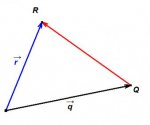Hey everyone, I am having a bit of difficulty with a problem involving vectors. It says:
A triangle ∆PQR in 3-space has vertices: P(2,4,0), Q(−3,5,3), R(−2,2,1). Use vectors to decide which one of the following properties the triangle has.
How exactly would I solve this problem? I first tried taking various dot products to find if any of them equaled to zero. I then found vectors through the line segments of PQ, QR, and RP, and I still haven't quite figured out what to do with it. The question asks at what vertices there is s right angle. Any thoughts?
Any feedback is appreciated guys, thanks.
A triangle ∆PQR in 3-space has vertices: P(2,4,0), Q(−3,5,3), R(−2,2,1). Use vectors to decide which one of the following properties the triangle has.
How exactly would I solve this problem? I first tried taking various dot products to find if any of them equaled to zero. I then found vectors through the line segments of PQ, QR, and RP, and I still haven't quite figured out what to do with it. The question asks at what vertices there is s right angle. Any thoughts?
Any feedback is appreciated guys, thanks.

